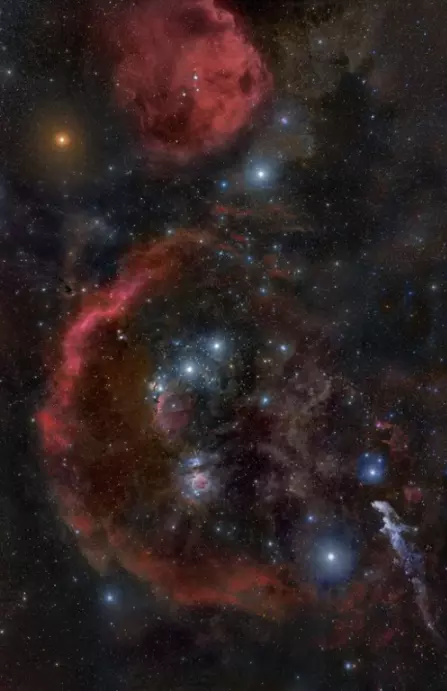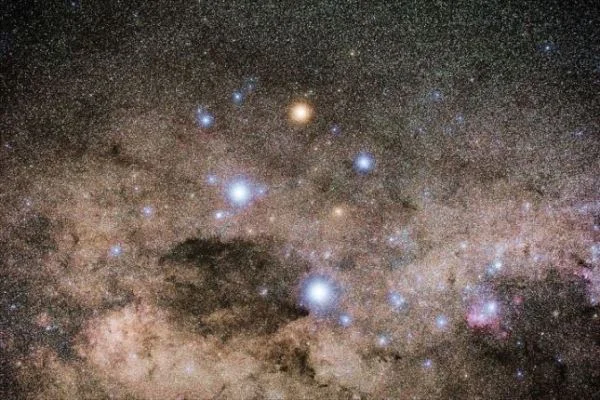Constellations are named areas of the celestial sphere that are used to divide the night sky into specific regions for easy reference. The modern constellations and their boundaries were defined by the International Astronomical Union (IAU) in the 1920s. They are based on the ancient constellations catalogued by the Greek astronomer Claudius Ptolemy in his Almagest in the 2nd century CE, as well as on the constellations created by European astronomers and cartographers since the Age of Discovery.
There are 88 constellations in the sky officially recognized by the International Astronomical Union. Thirty-six lie predominantly in the northern sky and 52 are found in the southern celestial hemisphere. The northern constellations are mostly based on Ptolemy’s 48 Greek constellations, while many of the southern ones that were invisible to the Greeks were not created until the 16th century.
Constellations vary greatly by size. The largest constellation in the sky, Hydra, stretches across 1302.844 square degrees of the sky while the smallest, Crux, occupies only 68.447 square degrees. Both lie in the southern sky. Hydra is visible to observers in mid-northern latitudes and Crux is not due to its location in the far southern sky. The largest constellation in the northern sky is Ursa Major, the Great Bear.
Where do constellations come from?
The ancient constellations that served as the basis for most of the modern 88 constellations were created by Babylonian, Assyrian and Egyptian observers thousands of years ago. Their exact origins and myths associated with them are largely lost. However, as these stars patterns were adopted by the Greeks, they were given new meanings and associated with figures from Greek mythology that we still know today. In Roman times, the constellations were given Latin names.
Fifty of the modern 88 constellations are based on the 48 Greek constellations listed by Ptolemy. They include some of the best-known constellations in the sky: Orion, Ursa Major, Ursa Minor, Lyra, Cassiopeia, Perseus, Pegasus, Auriga, Hercules, Draco, and the constellations of the zodiac.

The constellations Ursa Major an Ursa Minor are visible just right of centre. The arc of the Big Dipper’s handle leads to the bright Arcturus in Boötes, appearing low above the horizon. Arcturus sits at the base of an asterism known as the Kite, which lies between Corona Borealis (the Northern Crown, left) and the Big Dipper (right). The line of fainter stars between the Big and Little Dippers outline the tail of Draco, and the relatively bright star located below Alkaid at the tip of the Big Dipper’s handle is Cor Caroli, the luminary of Canes Venatici (the Hunting Dogs). Image: Constellation Guide
The only Greek constellation that is no longer in use is Argo Navis. Once the largest constellation in the sky, Argo Navis (the Ship Argo) represented the ship on which Jason and the Argonauts sailed to Colchis to retrieve the Golden Fleece. It was divided into three separate constellations – Carina (the Keel), Puppis (the Stern), and Vela (the Sails) – by the French astronomer Nicolas Louis de Lacaille in the 18th century.
Since the Greeks and Romans could not see the stars in the far southern sky, many of the modern-day southern constellations were not created until the Age of Discovery, when European navigators started exploring the southern hemisphere and charting the southern skies. The German astronomer Johann Bayer introduced 11 new constellations in his star atlas Uranometria (1603). These constellations were created by the Dutch-Flemish astronomer Petrus Plancius based on the sky charts provided by the Dutch explorers Pieter Dirkszoon Keyser and Frederick de Houtman. Seven of the modern 88 constellations were created by the Polish astronomer Johannes Hevelius in the 17th century. In the 18th century Nicolas-Louis de Lacaille created an additional 14 southern constellations during his stay in South Africa.
How did constellations get their names?
The names of the 88 constellations have different origins. The 48 Greek constellations catalogued by Ptolemy are either named after or associated with figures from Greek mythology and their Roman counterparts. For example, Lyra is the lyre of Orpheus, Cygnus is Zeus disguised as a swan, Aquila is Zeus’ eagle, Sagitta is the arrow of Hercules, and Corona Borealis is the crown of Ariadne. Ptolemy did not name these constellations and their Greek names do not necessarily correspond to the modern ones.
See: Greek constellations
The constellations that were not listed by Ptolemy were created and named between the 16th and 19th centuries. Those created based on observations made by Dutch explorers who travelled to the southern hemisphere in the late 16th century were mostly named after the exotic animals the explorers encountered on their journeys: Chamaeleon, Apus (the Bird of Paradise), Grus (the Crane), Tucana (the Toucan), Volans (the Flying Fish), etc.
Most of the constellations created by Nicolas-Louis de Lacaille were named after instruments: Antlia (the Air Pump), Fornax (the Furnace), Horologium (the Pendulum Clock), Pyxis (the Compass), Microscopium, Telescopium, etc. Mensa is an exception. It was named after Table Mountain (Mons Mensae), a flat-topped mountain overlooking Cape Town in South Africa, located near the observatory from which Lacaille made his observations.
The names of the 88 constellations are used in the designations of stars. The German astronomer and cartographer Johann Bayer created the original list of Bayer designations, which are still in use today. They consist of a Greek or Latin letter and the genitive form of the star’s host constellation. For example, Antares in Scorpius is designated Alpha Scorpii, Rigil Kentaurus is known as Alpha Centauri A (as the primary component in the Alpha Centauri system), and Regulus in Leo is Alpha Leonis.
Similarly, the English astronomer John Flamsteed used numbers and constellation names in genitive form to assign stars what are now known as Flamsteed designations in his 1725 catalogue. These are still commonly used for stars that do not have Bayer designations. Stars known mainly for their Flamsteed designations include 51 Pegasi, the first main sequence star discovered to have an exoplanet, and 61 Cygni, the star with the highest proper motion of all visible stars.
Constellation vs. asterism
The difference between the terms constellation and asterism is simple: constellations are areas of the sky and asterisms are patterns formed by two or more stars. Before the early 20th century, the terms were used synonymously as they both referred to star patterns. Once the International Astronomical Union (IAU) adopted the official constellation boundaries in the 1920s, constellations came to denote specific areas of the celestial sphere. Meanwhile, asterisms retained their original meaning.
In common use, the word constellation is still often used in reference to asterisms. For example, the Big Dipper is not a constellation but an asterism in the constellation Ursa Major (the Great Bear), the Kite is an asterism in Boötes, and the Northern Cross is an asterism in Cygnus (the Swan). In Ursa Major, the stars of the Big Dipper outline the Great Bear’s tail and hindquarters, while the Northern Cross forms the main body of the Swan.
While asterisms and constellation figures may have multiple variants, constellations have borders as clearly defined as those of countries on the world map. Since asterisms are not as strictly defined as constellations, there is no official list approved by the IAU. New ones are discovered by stargazers all the time.
See: Asterisms
Famous constellations
The best-known constellations are those that are the easiest to identify. For observers in the northern hemisphere, these are:
- Orion – recognizable for Orion’s Belt and the constellation’s hourglass figure outlined by Betelgeuse, Bellatrix, Rigel, Saiph and Belt stars Alnitak, Alnilam and Mintaka
- Ursa Major – home to the Big Dipper, one of the best-known asterisms in the northern sky
- Ursa Minor – home to Polaris (the North Star) and the Little Dipper
- Canis Major – home to Sirius, the brightest star in the sky
- Cygnus – dominated by the bright, large asterism known as the Northern Cross
- Lyra – recognizable for the Harp pattern formed by Vega with several other bright stars
- Cassiopeia – nicknamed the “W constellation” because its five brightest stars form a conspicuous W in the sky
- Scorpius – easily recognizable for the Scorpion’s claws and the Fish Hook asterism, formed by Antares with other bright Scorpius stars
- Sagittarius – dominated by the Teapot asterism
- Taurus – home to the Pleiades and the Hyades, bright open clusters marking the shoulder and head of the Bull
- Auriga – easy to identify for the hexagon pattern formed by Capella with the constellation’s other bright stars
- Leo – like Scorpius, it looks like the animal it represents, with the Sickle asterism outlining the Lion’s head and mane

Photo taken by Rogelio Bernal Andreo in October 2010 of the Orion constellation showing the surrounding nebulas of the Orion Molecular Cloud complex. Also captured is the red supergiant Betelgeuse (top left) and the famous belt of Orion composed of the OB stars Alnitak, Alnilam and Mintaka. To the bottom right can be found the star Rigel. The red crescent shape is Barnard’s Loop. The photograph appeared as the Astronomy Picture of the Day on October 23, 2010. Image: Rogelio Bernal Andreo (CC BY-SA 3.0)
Observers in the southern hemisphere will easily identify several constellations in the far southern sky that are mostly unknown to northern observers. These are:
- Crux – recognizable for the Southern Cross asterism, featured on a number of flags in the southern hemisphere
- Centaurus – home to first-magnitude stars Alpha and Beta Centauri and many other bright stars
- Carina – home to Canopus, the second brightest star in the sky, and to the Diamond Cross asterism

Wide field image of the Southern Cross, credit: Wikimedia Commons/Naskies (CC BY-SA 3.0)
Zodiac constellations
The zodiac constellations are the constellations that host the Sun as it makes its way across the sky. They are: Aries (the Ram), Taurus (the Bull), Gemini (the Twins), Cancer (the Crab), Leo (the Lion), Virgo (the Virgin), Libra (the Scales), Scorpius (the Scorpion), Sagittarius (the Archer), Capricornus (the Sea Goat), Aquarius (the Water Bearer), and Pisces (the Fish). The Sun’s apparent path is called the ecliptic. Most of the planets in the solar system travel within 8 degrees of the ecliptic.
The constellations of the zodiac were important to ancient cultures because they helped observers determine the time of year. In antiquity, the Sun at the First Point of Aries (or the Cusp of Aries) marked the beginning of spring and at the First Point of Libra, the beginning of autumn. These points marked the locations of the vernal and autumnal equinoxes. Due to the Earth’s axial precession, the equinoxes have since moved to the constellations Pisces and Libra.
The 12 constellations of the zodiac are familiar to casual observers by name, but not all of them are easy to identify in the night sky. The most recognizable ones are those that contain exceptionally bright stars and conspicuous asterisms: Taurus (Aldebaran, the V of Taurus), Gemini (Pollux and Castor), Leo (Regulus, the Sickle), Virgo (Spica, the Y of Virgo), Scorpius (Antares, the Fish Hook), Sagittarius (the Teapot), Aquarius (the Water Jar), and Pisces (the Circlet). The less conspicuous ones can be found using asterisms located in the same area of the sky.
In addition to the 12 constellations of the zodiac, the ecliptic also passes through Ophiuchus, a constellation that is not part of the zodiac family. Constellation families were defined by the American astronomer Donald H. Menzel, who included only the traditional zodiac constellations and assigned Ophiuchus to the Hercules family.

The large, faint V that dominates the left side of the image is the main pattern of the southern zodiac constellation Capricornus. It can be found left of the Teapot in Sagittarius, which sits just above the horizon (centre), or by following the line of the Shaft of Aquila (top), formed by Altair with the two bright stars flanking it, Tarazed and Alshain. Image: Constellation Guide
Constellation facts
Are constellations real?
The constellations themselves are not real. They are a representation of the sky from the point-of-view of observers on Earth. They are products of human imagination and form a two-dimensional map of the sky. The stars and deep sky objects within their borders are mostly unrelated to one another and lie at different distances from Earth. Nevertheless, the bright star patterns in constellations make it easy for observers to identify specific stars and locate deep sky objects they can observe in binoculars and small telescopes.
What are constellations used for?
Historically, constellation figures, asterisms and individual stars were used for celestial navigation and in agriculture. In ancient cultures, the rising and setting of certain stars signalled the change of seasons and time for harvest. Stars and constellations also played an important role in folklore, mythology, and various belief systems across the world. Today, the constellations are mostly used to refer to specific regions of the sky. In observational astronomy, the patterns formed by their brightest stars help observers identify fainter constellations and find deep sky objects.
Asterisms in constellations can be used to find the north and south celestial poles. Polaris, the current North Pole star, is part of the Little Dipper asterism and can be found using the stars of the Big Dipper. Polaris Australis, the South Pole star, is too faint to be useful in navigation, so the south celestial pole is commonly found using the Southern Pointers (Alpha and Beta Centauri) and the bright stars of the Southern Cross.
See: Pointer Stars
How to identify constellations?
Constellations are identified using the bright asterisms within their borders. Some of the most recognizable asterisms in the sky include Orion’s Belt in the constellation Orion, the Big Dipper in Ursa Major, the Little Dipper in Ursa Minor, Cassiopeia’s W, the Southern Cross in Crux, the Fish Hook in Scorpius, the Sickle of Leo, the Teapot in Sagittarius, the Square of Pegasus in Pegasus and Andromeda, and the Northern Cross in Cygnus. Fainter but still easily discernible asterisms include the Keystone in Hercules, the House in Cepheus, the Kite in Boötes, the Water Jar in Aquarius and the Circlet of Pisces.

The W of Cassiopeia and the Segment of Perseus, image: Constellation Guide
Fainter constellations can be found using the bright asterisms in the constellations that lie in the same area of the sky. For instance, Canes Venatici is found below the handle of the Big Dipper in Ursa Major, Lepus lies under the feet of Orion, and Sagitta is located between the Northern Cross in Cygnus and the Shaft of Aquila, or between the beak of the Swan, marked by Albireo, and the head of the Eagle, marked by Altair.
Depending on the observer’s location, some constellations will only appear in the northern sky, while others will stay in the southern. For example, the northern circumpolar constellations Ursa Major, Ursa Minor, Draco, Cepheus, and Cassiopeia stay in the northern sky for observers in mid-northern latitudes. Depending on the time of year, they may appear in the northeast or northwest, but never in the southern sky. The same goes for the southern circumpolar constellations (Carina, Centaurus and Crux).
Why do we see different constellations throughout the year?
We see different constellations in the sky in different seasons because stars rise and set two hours earlier each month. They move across the sky by about 90 degrees from one season to the next, taking a year to complete the full 360-degree circle. For this reason, different constellations are visible in the evening sky at different times of year. Orion, for example, is best seen in the winter, Virgo in the spring, Aquila in the summer, and Pegasus in the autumn.
The 88 constellations
| Constellation | English name | Visible between latitudes |
| Andromeda | Andromeda | 90°N – 40°S |
| Antlia | Air Pump | 45°N – 90°S |
| Apus | Bird of Paradise | 5°N – 90°S |
| Aquarius | Water Bearer | 65°N – 90°S |
| Aquila | Eagle | 90°N – 75°S |
| Ara | Altar | 25°N – 90°S |
| Aries | Ram | 90°N – 60°S |
| Auriga | Charioteer | 90°N – 40°S |
| Boötes | Herdsman | 90°N – 50°S |
| Caelum | Chisel | 40°N – 90°S |
| Camelopardalis | Giraffe | 90°N – 10°S |
| Cancer | Crab | 90°N – 60°S |
| Canes Venatici | Hunting Dogs | 90°N – 40°S |
| Canis Major | Greater Dog | 60°N – 90°S |
| Canis Minor | Smaller Dog | 90°N – 75°S |
| Capricornus | Sea Goat | 60°N – 90°S |
| Carina | Keel | 20°N – 90°S |
| Cassiopeia | Cassiopeia | 90°N – 20°S |
| Centaurus | Centaur | 25°N – 90°S |
| Cepheus | Cepheus | 90°N – 10°S |
| Cetus | Whale (or Sea Monster) | 70°N – 90°S |
| Chamaeleon | Chameleon | 0° – 90°S |
| Circinus | Compass (drafting tool) | 30°N – 90°S |
| Columba | Dove | 45°N – 90°S |
| Coma Berenices | Berenice’s Hair | 90°N – 70°S |
| Corona Australis | Southern Crown | 40°N – 90°S |
| Corona Borealis | Northern Crown | 90°N – 50°S |
| Corvus | Crow | 60°N – 90°S |
| Crater | Cup | 65°N – 90°S |
| Crux | Southern Cross | 20°N – 90°S |
| Cygnus | Swan | 90°N – 40°S |
| Delphinus | Dolphin | 90°N – 70°S |
| Dorado | Dolphinfish | 20°N – 90°S |
| Draco | Dragon | 90°N – 15°S |
| Equuleus | Little Horse (Foal) | 90°N – 80°S |
| Eridanus | Eridanus (river) | 32°N – 90°S |
| Fornax | Furnace | 50°N – 90°S |
| Gemini | Twins | 90°N – 60°S |
| Grus | Crane | 34°N – 90°S |
| Hercules | Hercules | 90°N – 50°S |
| Horologium | Pendulum Clock | 30°N – 90°S |
| Hydra | Hydra | 54°N – 83°S |
| Hydrus | (male) Water Snake | 8°N – 90°S |
| Indus | Indian | 15°N – 90°S |
| Lacerta | Lizard | 90°N – 40°S |
| Leo | Lion | 90°N – 65°S |
| Leo Minor | Smaller Lion | 90°N – 45°S |
| Lepus | Hare | 63°N – 90°S |
| Libra | Scales | 65°N – 90°S |
| Lupus | Wolf | 35°N – 90°S |
| Lynx | Lynx | 90°N – 55°S |
| Lyra | Lyre (Harp) | 90°N – 40°S |
| Mensa | Table Mountain | 4°N – 90°S |
| Microscopium | Microscope | 45°N – 90°S |
| Monoceros | Unicorn | 75°N – 90°S |
| Musca | Fly | 10°N – 90°S |
| Norma | Level | 30°N – 90°S |
| Octans | Octant | 0°- 90°S |
| Ophiuchus | Serpent Bearer | 80°N – 80°S |
| Orion | Orion (the Hunter) | 85°N – 75°S |
| Pavo | Peacock | 30°N – 90°S |
| Pegasus | Pegasus | 90°N – 60°S |
| Perseus | Perseus | 90°N – 35°S |
| Phoenix | Phoenix | 32°N – 80°S |
| Pictor | Easel | 26°N – 90°S |
| Pisces | Fish | 90°N – 65°S |
| Piscis Austrinus | Southern Fish | 55°N – 90°S |
| Puppis | Stern | 40°N – 90°S |
| Pyxis | Compass (mariner’s compass) | 50°N – 90°S |
| Reticulum | Reticle | 23°N – 90°S |
| Sagitta | Arrow | 90°N – 70°S |
| Sagittarius | Archer | 55°N – 90°S |
| Scorpius | Scorpion | 40°N – 90°S |
| Sculptor | Sculptor | 50°N – 90°S |
| Scutum | Shield (of Sobieski) | 80°N – 90°S |
| Serpens | Snake | 80°N – 80°S |
| Sextans | Sextant | 80°N – 90°S |
| Taurus | Bull | 90°N – 65°S |
| Telescopium | Telescope | 40°N – 90°S |
| Triangulum | Triangle | 90°N – 60°S |
| Triangulum Australe | Southern Triangle | 25°N – 90°S |
| Tucana | Toucan | 25°N – 90°S |
| Ursa Major | Great Bear | 90°N – 30°S |
| Ursa Minor | Little Bear | 90°N – 10°S |
| Vela | Sails | 30°N – 90°S |
| Virgo | Virgin (Maiden) | 80°N – 80°S |
| Volans | Flying Fish | 15°N – 90°S |
| Vulpecula | Fox | 90°N – 55°S |